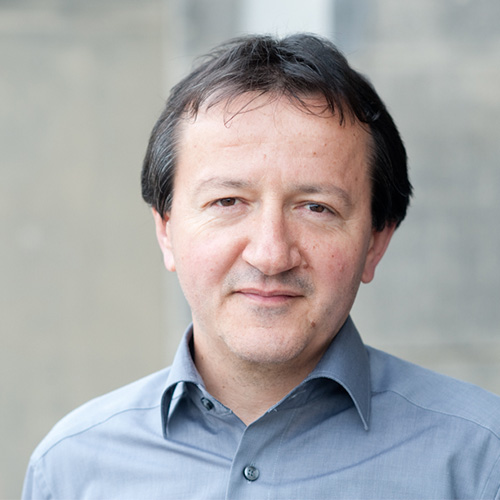Scientific Programme
Biomechanics & Motor control
IS-BM01 - Neuromotor stability control and inter-task generalisation in irregular human gait
Date: 01.07.2025, Time: 12:00 - 13:15, Session Room: Arengo
Description
The speed of actual walking is rather a time-varying trajectory that is modulated by task urgency, individual neuromuscular capacity or locomotor perturbations, and therefore steady locomotion in real-world environments is more an exception than the rule. Movement on irregular surfaces is associated with external mechanical perturbations, increased gait instability and increased risk of falls. Therefore, research that promotes our understanding of how biological systems control and regulate stability in the presence of perturbations and how adaptation in stability control can be generalised across tasks, is very important for safe and effective locomotion. Mechanical preflexes, sensory feedback and feedforward commands are mechanisms that control the stability of biological systems, are complementary and can be modified through experience and motor learning. In the session, we will focus on challenging locomotor conditions such as walking on uneven ground and different types of gait perturbations, as walking is the most common fall-related activity in humans and missteps and trips account for the majority of all falls. We will address (i) how the human neuromotor system regulates the translational and rotational behaviour of the whole-body to maintain stability, (ii) how generalisation of adaptation is possible and how it may be limited across gait perturbation tasks and, (iii) how biarticular mechanisms of the musculoskeletal system may contribute to stability control.
Chair(s)

Adamantios Arampatzis
Humboldt-University Berlin, Department of Training and Movement Sciences
Germany

Speaker A
Maria Elissavet Nikolaidou
National and Kapodistrian University of Athens, School of Physical Education and Sport Science
Greece
Read CVECSS Rimini 2025: IS-BM01
Stability regulation mechanisms of the whole-body during gait on uneven ground
Leg posture and muscle activation patterns are important mechanisms that control two important measures of stability, namely margin of stability (MoS) and whole-body angular momentum, for maintaining dynamic balance during stable and unstable locomotion (1,2). Leg posture adjustments and muscle activation influence the base of support and the moment arm from the centre of mass (CoM) to the ground reaction force (GRF) vector, affecting stance phase dynamics. Experience-based and visually guided anticipatory adjustments in leg posture and activation patterns provide the opportunity to proactively plan movement initiation and modify subsequent responses, facilitating robust and stable gait on uneven ground. Therefore, understanding the neuromuscular and biomechanical mechanisms that control the translational and rotational behaviour of the whole-body during movement on uneven ground will provide important knowledge for effective stability control and fall prevention. During hole negotiation, we found a decrease in MoS and an increase in the peak-to-peak range of the whole-body angular momentum compared to level walking, especially in the frontal plane, indicating an increased challenge to body stability. As a result, the rate of the angular momentum, which is similar to the external moment of the GRF around the CoM, was increased during the negotiation of the hole predicting a higher demand in the muscles of the ipsilateral leg to control body stability. On the other hand, the decrease in the medio-lateral moment arm of the GRF at touchdown indicated an anticipatory foot displacement strategy to control the angular momentum towards the contralateral leg. Furthermore, the muscle activation patterns and the resulting kinematics of the contralateral leg before touchdown also showed proactive adjustments to regulate the kinetic CoM energy and to reduce the contribution of gravity to the angular momentum rate. Nevertheless, the high activation of the soleus, gastrocnemii and vastii muscles of the ipsilateral leg required to manage the total CoM energy during hole negotiation dominated the aforementioned anticipatory adaptations and resulted in the increased range and rate of angular momentum. We argue that the high activation of the plantar flexors and knee extensors during the stance phase in the hole suggests that the regulation of total CoM energy at the expense of an increase in whole-body angular momentum is a reasonable trade-off in the regulatory stability mechanisms, and demonstrates the challenge of moving on uneven ground. The presentation will address (i) the translational and rotational behaviour of the whole-body, (ii) the functional diversity in activation between the ipsilateral and contralateral leg muscles and (iii) how humans regulate MoS and whole-body angular momentum to maintain stability during hole negotiation. REFERENCES: 1) Hof et al. 2010, J Exp Biol 213, 2655-2664 2) Neptune and Vistamehr 2019, J Biomech Eng 141, 0708011–07080

Speaker B
Kiros Karamanidis
University of Koblenz, School of Applied Sciences
Germany
Read CVECSS Rimini 2025: IS-BM01
Generalizability of balance recovery response adaptations from mechanical- and virtual-based gait perturbation exercises
Human bipedal locomotion faces various perturbations to stability that require neuromotor adjustments and adaptations to maintain postural integrity and avoid falls. Previous research suggests that the central nervous system monitors and corrects motor responses by predicting sensory consequences of perturbations (1). However, these predictions must accurately reflect the nature of the perturbation, and hence, motor control is continuously refined based on error-feedback information. This ability of the neuromotor system to adapt suggests that enhanced balance recovery responses developed through exposure to specific perturbations may improve coping with altered forms of the exercised task (2). Understanding the factors that enable the neuromotor system to improve and transfer balance recovery mechanisms across diverse perturbation tasks and environmental conditions is essential for enhancing fall resilience in both healthy and pathological conditions. Using unpredictable mechanical-based perturbations during walking, our recent findings support the hypothesis that the neuromotor system can facilitate improved reactive balance responses by enhancing neuromuscular coordination, along with retaining balance improvements over several years, potentially reducing fall risk. Acquiring and retaining fall-resistance skills appear to rely more on neural rather than muscle-tendon capacities, emphasizing the neural system’s critical role in maintaining stability under challenging conditions. In addition to perturbations in physical environments, visual-based gait perturbations in virtual environments stimulate motor skill learning that can be retained for several weeks. Our data further indicate that the neuromotor system can partly transfer those balance recovery adaptations from virtual to physical environments. However, the generalizability and transfer of stability recovery mechanisms from one task to another and from the virtual to physical environments seem to depend on perturbation direction and the degree of similarity in neuromuscular control patterns between tasks. Furthermore, balance recovery performance of an individual affects the responsiveness to perturbation exercises and therefore task demand should be considered when accessing transfer potential, particularly for studies on populations with varying locomotor capacities. The current presentation will focus on our recent findings about (i) how gait stability and adaptability during unpredictable mechanical-based gait perturbations are affected by age, and (ii) whether transfer of enhanced stability recovery responses to novel perturbation tasks is impacted by neuromuscular function, and (iii) whether visual-based gait perturbation exercises in a virtual environment benefit dynamic stability in physically challenging environments. References 1. Shadmehr 2017, J. Neurosci.37, 1663-1671 2. Harper et al. 2021, Brain Sci. 11, 402

Speaker C
Adamantios Arampatzis
Humboldt-University Berlin, Department of Training and Movement Sciences
Germany
Read CVECSS Rimini 2025: IS-BM01
Activation patterns and biarticular mechanisms of power sharing between the synergistic muscles of the triceps surae during human gait perturbations
There is evidence for a critical role of the ankle joint in human locomotion and indications for muscle-specific functional relevance of the plantar flexors during perturbations (1). The soleus (Sol), gastrocnemius medialis (GM) and gastrocnemius lateralis (GL) form the triceps surae muscle and operate together as ankle extensors to generate moments and perform power at the ankle joint. Although the three muscles work synergistically, they have important differences in function, geometry and size. The Sol, as monoarticular muscle, acts around the ankle joint, while the GM and GL are biarticular and act across the ankle and knee joints. The biarticular gastrocnemii may transfer power and energy between the two joints (2) increasing intrinsic stability by reducing the effort required for neural control. Recently, we found a significant increase in the energy transfer potential between the ankle and knee joint via the biarticular gastrocnemii in both trip-like (1.6-fold) and drop-like (2.5-fold) perturbations compared to unperturbed walking. This modulation was consistent during the unpredictable and adapted walking perturbations and was accompanied by a high activation of the gastrocnemii, indicating a crucial involvement of biarticular mechanisms to counteract locomotor disturbances. Subsequently, Achilles tendon (AT) force and AT elastic energy storage and recoil were quantified during drop-like perturbations. Based on the AT force as a proxy for triceps surae muscle force, the generated moment and the performed power and work of the monoarticular Sol at the ankle joint and the biarticular gastrocnemii at the ankle and knee joints were calculated. We found that the biarticular mechanisms of the gastrocnemii significantly affect the mechanical power and work through an ankle-to-knee joint in the first part and a knee-to-ankle joint energy transfer in the second part of the stance phase after the perturbations. The transfer of energy from the ankle to the knee joint via the biarticular gastrocnemii provides evidence of an important contribution of biarticular mechanisms to the absorption of body energy during unpredictable trials, where beneficial mechanisms to control stability modulated by prediction are not available. The presentation will focus on (i) the consequences of unpredictable and predictable gait perturbations on the translational and rotational behaviour of the whole-body, (ii) the functional diversity of activation and power sharing between the synergistic Sol, GM and GL muscles with a special focus on biarticular mechanisms to control gait stability, and (iii) how improvements in gait stability through prior experience and motor learning are related to the interplay between activation and biarticular mechanisms for power and energy transfer between the ankle and knee joints. REFERENCES: 1) Dick et al. 2021, Proc Biol Sci, 31, 288(1947):20210201 2) van Ingen Schenau 1989, Hum Mov Sci 8, 301-337
